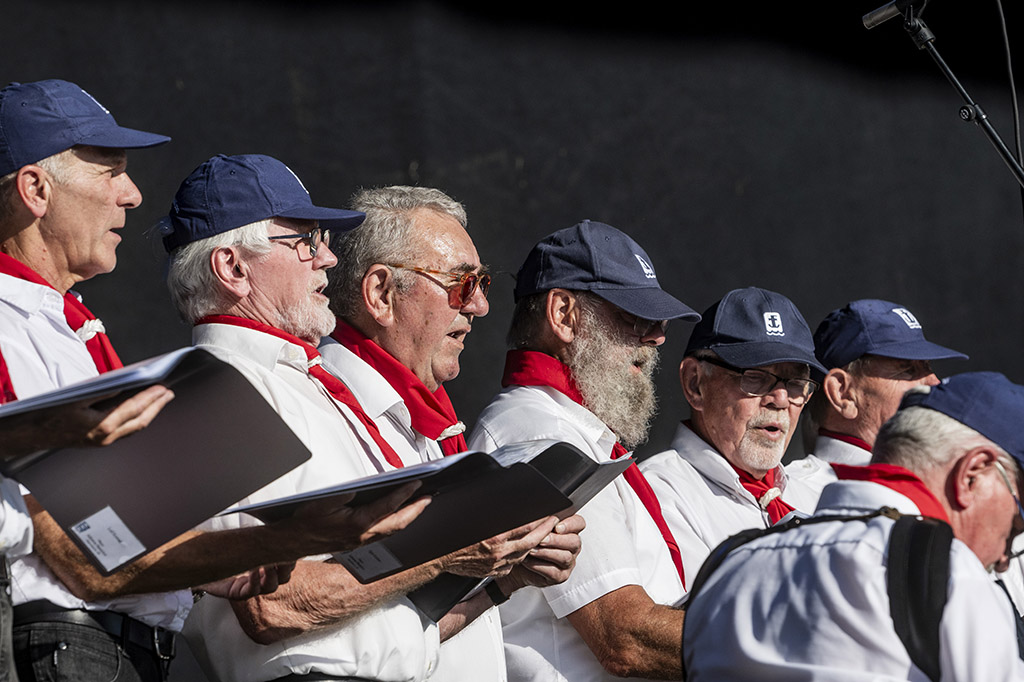Party in the harbour – reflections from Performing Landscapes Aabenraa
By Francois Top
From where I was I could not smell the barbecue from the big party in the harbour. Today the smell was quite neutral, the Danish Crown liver pate factory wasn’t in action, neither farmers spraying manure on the landscape. Human activity was apparently pending for a while.
The air was burning hot, dry, like a canicular summer day, but with a touch of climate change in the atmosphere. The sunlight was telling that fall was coming soon, horizontal vivid rays of yellow light hitting the industrial dusty constructions.
Tung tung tung. When I first saw the helicopter, I thought: This time, Trevor Davies, you go too far! From the very first moment I was amazed by the energy and capacities of that guy, but this time he was going over the border: Metropolis was turning into a Netflix production!
Then I saw Trevor’s Volvo parked near Danish Crown factory, new age temple of pate lever, industrial gastronomic crematorium. He was standing there in his art operator outfit, black shirt and pony tail, as usual. I was then feeling reassured, but still wondering what was this helicopter doing, irritating giant bug over my head, making endless roundtrips over the harbour. Tung tung tung.
On the other side of the road I saw poet Janus Kodal standing on a waste ground/development site. Not long ago there used to be an industrial building there. It was that kind of plot that you find in industrial areas: the old warehouses had been turned down, the ground had been flattened and cleaned up, and now it was waiting for its next use. I remembered reading about some projects for building a museum there. Almost in front of the liver pate factory. A good match, I thought, food and culture.
Janus was wearing a chemical suit and moving a tube of plastic in circles over his head: signals of distress? The link in between Janus and the helicopter was obvious. Janus Helicoidal. An apocalyptical setting on this dead industrial ground.
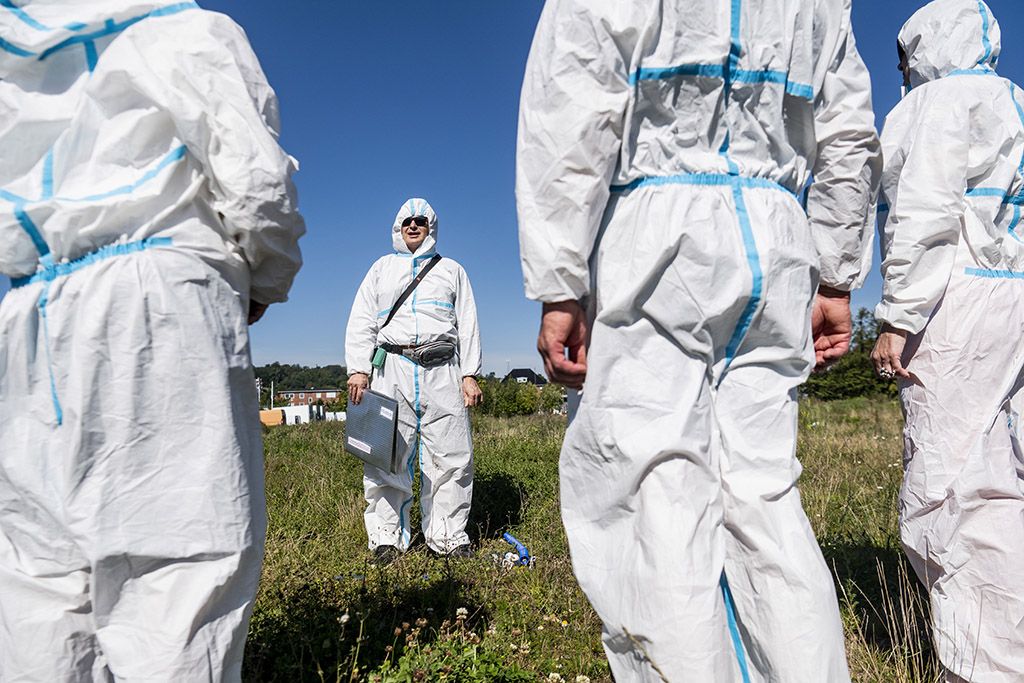
Description of the performance with Janus
We are a group of 4 going to Janus interactive performance. We have to wear chemical suits like him. He will lead us to different places in the harbour.
We got into the chemical suits, I guess for being physically connected to a fictious apocalyptic situation or at least feeling symbolically physically separated from the present context. We got instructions: We would get assignments from Janus and we should use our iPhones and an app for sending our recordings to Janus, which would later be broadcasted by sound artist Claus Haxholm, and the whole group would go a boat for a trip in the harbour.
We follow Janus to where fishermen park their little boats. Janus is hanging a bill of 100 dkr. to a fishing string and throwing it in the water, as if he wanted to hook a fish. I’m questioning: Does it mean that fish don’t care about money? That the harbour is money itself? That money is a hopeless invention from us but has destroyed the whole natural world? That we look at nature for the profit we can make from it? I’m not sure about the metaphor, but during this performance Janus didn’t catch anything but our attention. He was playing a recording of two women voices, Pia and Greta. We, the audience, were watching carefully. He gave us an assignment and I recorded a kind of poetry, words of mine, spontaneous, about silver reflections on water.
We followed poet Janus Helicoidal inside a big long warehouse: Smell of fermentation, moist and dust floating in the air of a purely industrial environment where a human can feel comfortable only if he’s paid for it. We walked through a large corridor made of concrete and reached a gigantic room filled up with sand, a mountain of sand. The place had a peculiar acoustic; or no acoustic at all, the sand absorbing everything, maybe even time. The mountain was alive, in a perpetual movement, like an hourglass or a fountain, the sand sliding down – dripping like a stalactite, moving forms, expanding horizontally.
It felt like being in a kind of prehistorical gothic church, confronted to a strange mysterious cult, both natural and industrial. Above the mountain of sand, on the wall, a propeller was turning in a round ventilation window, like a rosette in a gothic church.
We walked further, leaving the sand temple for going outside, and we reached a fence, a bit like a prison fence, facing the water. On the fence were drawings, maps and texts hanging, made by other participants, probably children.
Janus gave us an assignment: What does the harbor look like in 30 years? I recorded a pseudo poetry about a future, when a gigantic liver pate will grow from Danish Crown and invade the harbor, first floating at the surface of water, with champignons and bacon slices. Hundreds of people will swim to eat from it, until complete suffocation. Slowly the liver pate will grow and cover the whole place, absorbing clouds and sky.
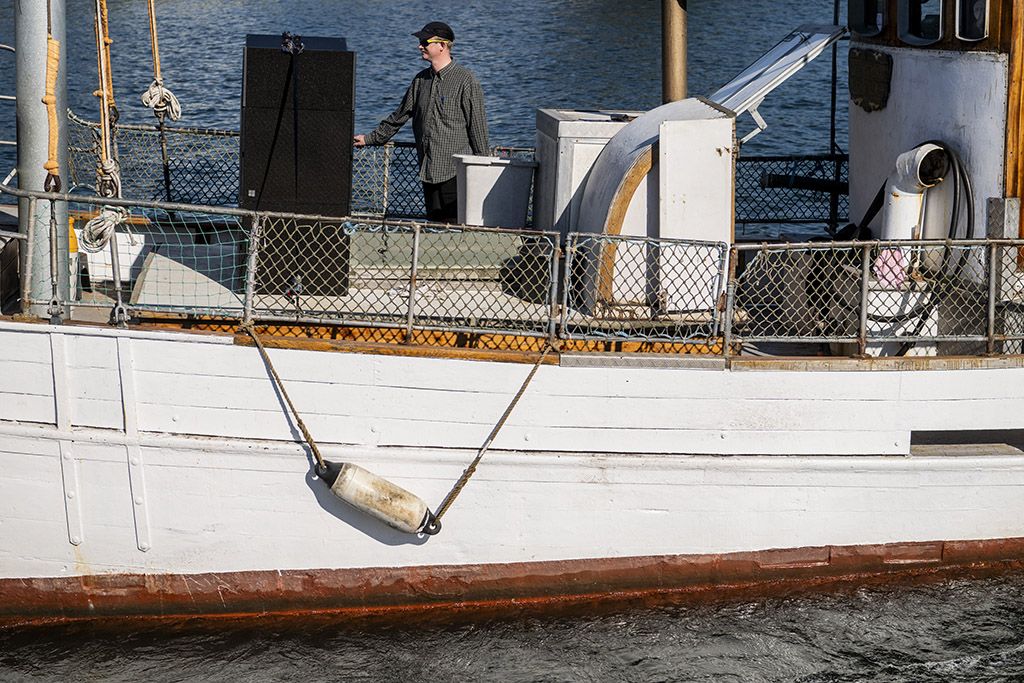
Joining the boat and broadcasting sounds on the harbor
We joined the crew of an old fishing boat with sound artist Claus, who mixed and broadcasted our recordings from powerful speakers while sailing around in the harbor. The words seemed to spark like bubbles in the air and fall at the surface of water, mixed with the smell of gazoil.
I felt a bit like a child having prepared some school performance and have to perform it after, in front of an abstract public. I was expecting being hit by the words of Janus the poet himself rather than my own words. I had expected to be pushed more outside of my comfort zone, I felt like rolling in the sand mountain and scream words out of my body in what I thought looked like a giant sand creature alive. It felt a bit like being driven in a pedagogical guided tour of the harbor with climate change ambiance. Of course I discovered places from another perspective, the hidden gigantic sandhourglass and the rosette are impressive. And now when I pass by the harbor I can’t avoid thinking about the inside of this industrial chapel.
Le bateau ivre electronique de Claus
When I saw the old fishing boat wandering on the fjord I thought about Corto Maltesse and the romantico exotic universe of Hugo Pratt, it looked like a funny romantic and anachronistic poetical statement. I then thought about “le bateau ivre” of Arthur Rimbaud, the boat of Claus navigating like a drunk machine, screaming, roaring, ejecting throwing sounds in the air and at the surface of the water. A floating machinery that swallows words and noises from human activities and ejecting everything on its way around the harbor, bubbles of sounds vanishing in the atmosphere, sparking molecules of noises falling on the surface of the fjord, going back to nature: “rien ne se perd rien ne se crée tout se transforme” as Lavoisier wrote.
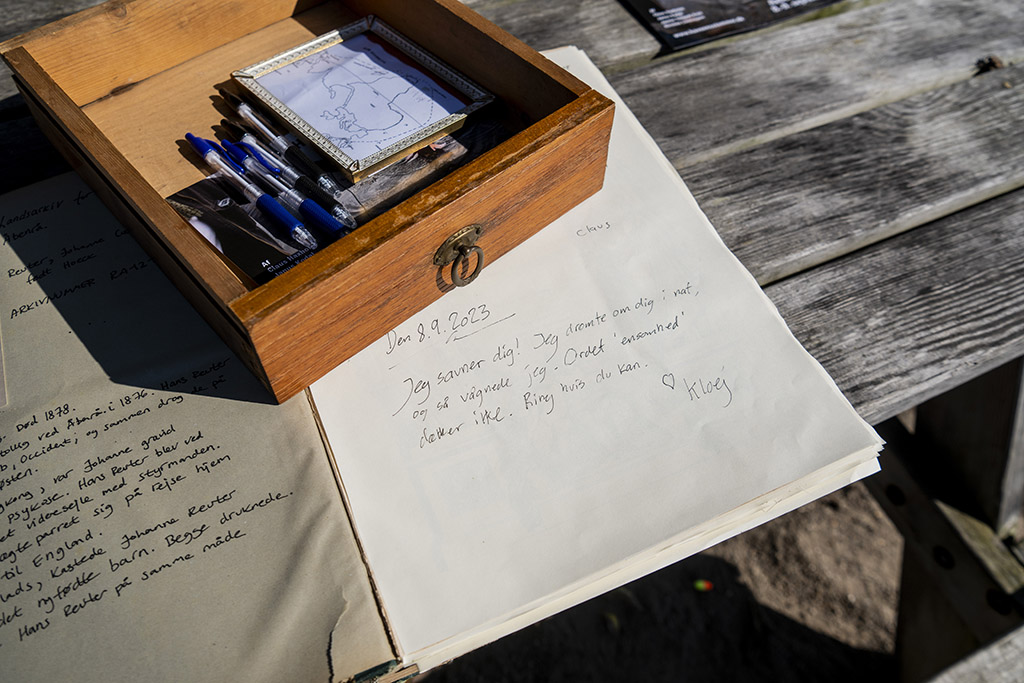 Jannie Schjødt Kold’s ultramarine voices
Jannie Schjødt Kold’s ultramarine voices
The display is discrete with speakers displayed on the coast close to the water. If I didn’t know that the speakers were playing I could have believed that the voices were coming from the water. Voices, memories, stories. My eyes were attracted by the reflection of the sunlight through the seaweeds, moving like long tentacles, making a strange ballet over the polished round >galleys< of different tons and sizes.
It feels like all memories are moving into the sea, carried by the streams, dancing like those long seaweeds in the reflection of sunlight. A voice of a woman is telling a story, about a life, about a journey, in a different time. It feels like the voice of the sea, touching and powerful. But also nostalgic, and maybe sad.
I wished at that moment that nature elements had more voices like that that we could experience the force of nature, an experience that we have less and less capacity to realize, only maybe when natural forces are manifesting their anger. A tsunami, an earthquake, a lightning, a forest fire. Attracted deeply into the water, hypnotized by the voices like a mermaid “complainte” I remembered once swimming far in the fjord though shiny jelly fish, thousands of them glittering in the shiny water, they seemed to be greeting in silence and turning on themselves, their contact was soft like skin and I had the impression they were laughing at my contact, a ballet of round starts navigating in the happiness of the deep. I was feeling like diving in a fluid sky upside down, a liquid Milkyway. I was thinking about that experience while listening to Jannies voices and decided to get in the water and see if the jelly fish were still dancing in the deep.
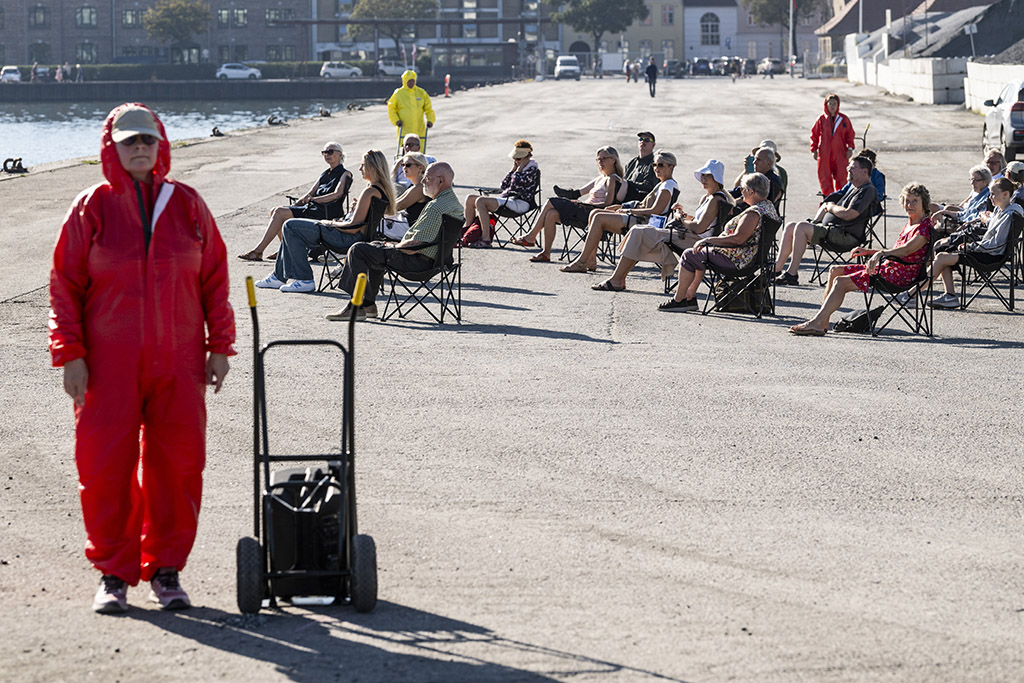 Kristine and Teletubbies
Kristine and Teletubbies
Getting into the area of the harbor where gravel is stored in gigantic hills, we walk in a group and are being guided towards the canal. Strange sounds, roaring, grumbling, are raising from behind the hills of gravel, sounds are at the edge of complaints or suffering. A group of people appears, dressed up in kinds of chemical suits but red and yellow, which make me think that they look like of Teletubbies. They walk around pulling a speaker on wheels and I understand that the sound from the speaker is a recording of their own voice.
We are guided to the canal where we are seated in a half circle just like for a concert. The Teletubbies performing further. Sound artist Kristine has been conducting them; extracting and amplifying sounds from the structural elements of the harbor, while Teletubbies keep grumbling in a symphony of complaints and chaos.
It feels as if I am part of a group therapy, which is fine since I was always convinced of the therapeutical aspect of art, beneficial both for the participant, the audience, and the artist. The temperature is still very high for this time of the year, I fall in a semi coma on my chair and melt into the harbor atmosphere with the symphony of chaos and have a kind of out of body experience, flying just at the edge of the hills of sand, and then falling in the water.
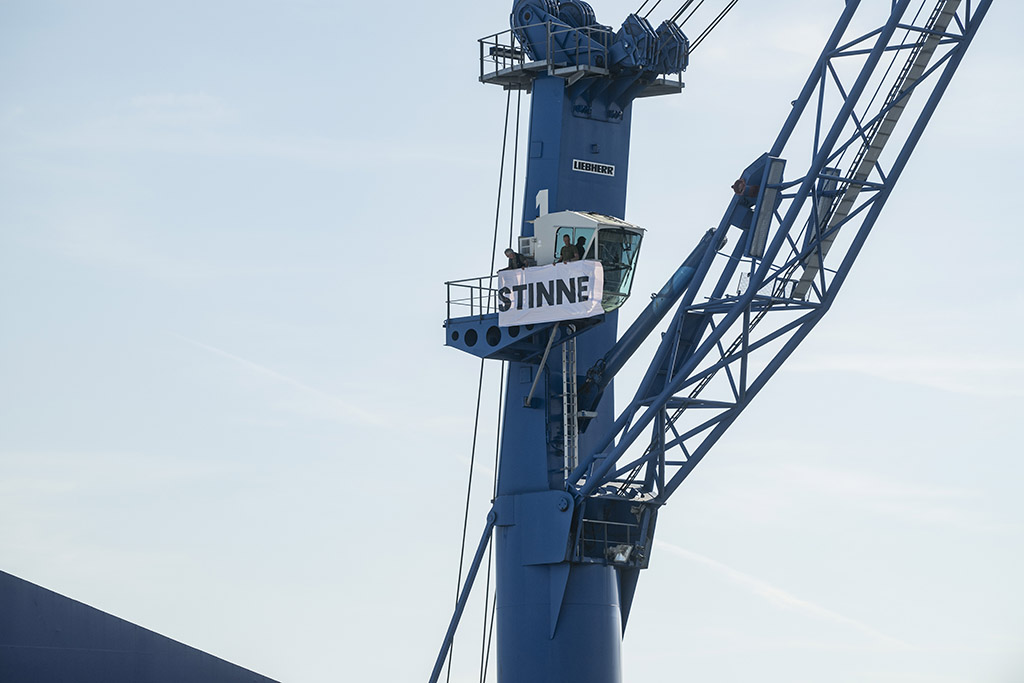 End of the party
End of the party
There were a lot of people in the harbour for the baptism of the big new crane. All kinds of people, family, farmers, worker,s handicapped, dogs, children, retired people, firemen, policemen and even an ambulance. All of Rødekro was there and maybe also Løjt Kirkeby and Stubbæk and Genner and Bolderslev and maybe Tinglev. They were eating carbonized sausages with chemical hotdog bread and ketchup and french mustard and a diversity of chemical drinks of different colours. And beers, a lot of beers. Rarely you see so many people gathered in one place in this part of the world. Many of them actually had the chance to see this little part of the world from a higher perspective from the helicopter, 3000 dkr. /10 min round trip.
There was a stage and some bands performing live music, and the poet Janus climbed the stage to meet a choir of retired men and men with mustaches, in a kind of uniform like boy scouts, all from Sønderjylland. The setting was very Monty Python like, I remebered the lumberjack sketch. Janus took the microphone to great the little audience gathered in front of the stage, every statement he pronounced was followed by a verse from the chorus. This was the official baptism of the big new harbor machines, who got names that day, I’m not sure if any of them was named Pia or Greta, but the gigantic cranes were baptized like ships are baptized, like the Rainbow Warrior, the Titanic or Nautilus.
It was nice to go out, nice to try something new with different people with or without helicopter, with or without carbonized hot dogs, I liked the summer atmosphere
and all these people around taking advantage of climate change. Yes, why not dying slowly in happiness, letting the sun burn our illusions and letting nature take over slowly. Strange feeling to be part of the end of a world. Strange to see this happiness of children biting in their sausages, the slaughter factory isn’t far away, we could hear the penicilined pigs screaming in their concentration camps, bathing in their warm excrement.
Come to think of it: Art nature mankind industrial apocalypse climate catastrophe ecological disaster and me
The question is always to find out what art is about, what is art and the role of art in society. One specific system we as human beings created in our process of development is categorizing. Art is a category definitely, even if I believed once that art was a non-category, a space where things can happen without a net of morality and other conventions.
The role of the artist is maybe to guarantee sensitiveness, to make us reconnect with the internal fundamental life process in ourselves. The artist is working with processes of emotion, processes of feeling, perception and senses, maybe questioning the nature in ourselves.
Emotions are not specific to human beings, emotions are chemical processes generated by the nature elements in ourselves, whatever religions try to make us believe, as well as marketing strategies. The artist feels first and acts after, whereas other dominant categories rather act first and feel after. The dominant categories have expanded a contentless permanent desire through a myth of progress, letting us believe it is a process of natural evolution. All the fake artificial needs we created – the whole economy is is depending on it.
Actually we need very little: We need to re-appropriate our perception, our senses.
I’m not sure that we understand nature better now that we see our condition is threatened. We can’t survive unless we reconnect with more awareness of natural processes and nature elements in our constitution, body, mind.
A strange fact is that we do not focus on feeling nature in ourself, the nature that created us, makes us breathe, move, live and stand up. We look at nature around us and consider it for our survival, with the idea that we own nature, nature in the form of a vast supermarket continuosly supplying to what we need.
In the Metropolis Landscape programs we see variations of attempts to stimulate our awareness about this crucial link to nature and the necessity to communicate about it. Nothing can happen until we get physically confronted or gathered and communicate, share, develop, act.
I remain perplexed concerning the use of tools, equipments and electronic tools, all the tools we need to substitute to our perception for understanding environment , instead of raising our awareness of nature and reconnecting physically with natural elements, growing and expanding consciousness of the world we live with, feeling nature inside ourselves.
I miss the shamanic play and guidance of Joseph Beuys. Art became so much of a media of communication that art could maybe create its own communication. It is not reductive to look at art as a language in itself.
To be a catalyzer is challenging in that situation. I don’t wish to be guided in our dying world; I want to be pushed out of my perception limits and get my awareness boosted, my consciousness enlarged by through interactive art experiences. I like to feel my mind and my body free and feel the natural elements in me and around me in a 5th dimension. I need to be taken where I haven’t been before. That’s what I expect from art – without artificial substances if possible. I want my senses and my perception to be boosted and to grow a higher consciousness and feel the future today.
My mind and body want to re-appropriate an authentic, supra experience and permanent experience of nature, to rediscover the meaning of natural elements in a landscape shaped reshaped and de-shaped by a certain type of humanity.
Læs mere om Havnens Stemmer – Performing Landscapes Aabenraa, der fandt sted 8.-9. sept. 2023
Fotos: Palle Peter Skov



